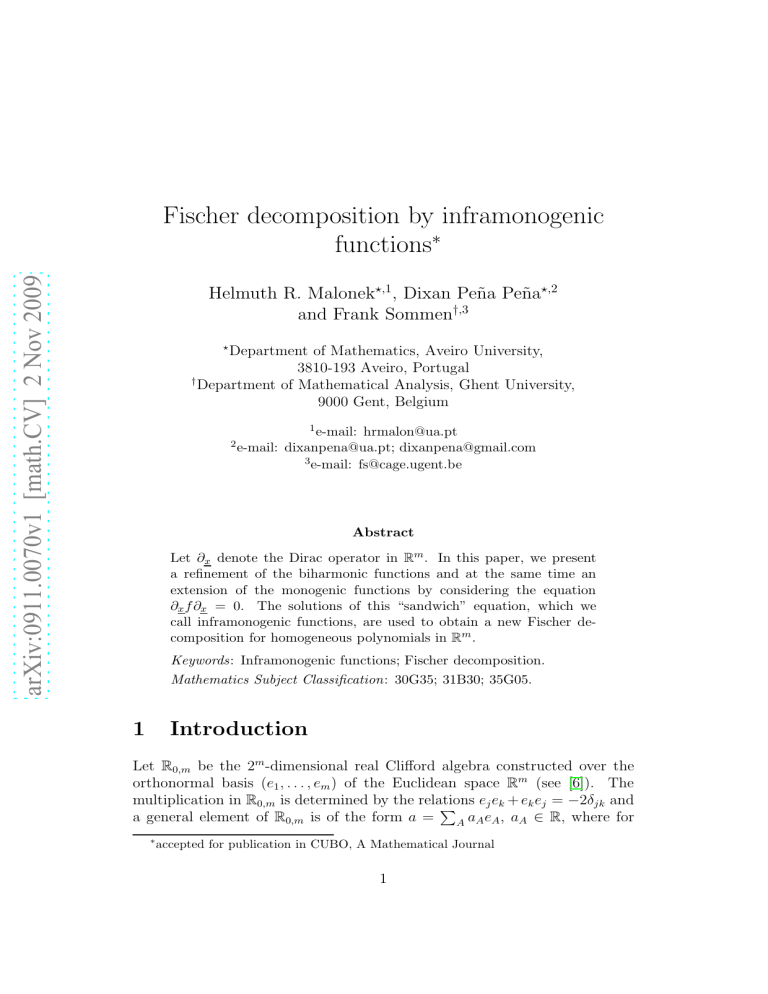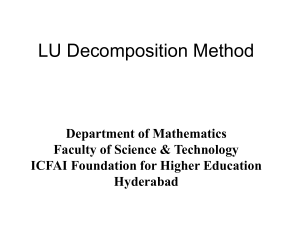
arXiv:0911.0070v1 [math.CV] 2 Nov 2009
Fischer decomposition by inframonogenic
functions∗
Helmuth R. Malonek⋆,1, Dixan Peña Peña⋆,2
and Frank Sommen†,3
⋆
Department of Mathematics, Aveiro University,
3810-193 Aveiro, Portugal
†
Department of Mathematical Analysis, Ghent University,
9000 Gent, Belgium
1 e-mail:
2 e-mail:
hrmalon@ua.pt
dixanpena@ua.pt; dixanpena@gmail.com
3 e-mail: fs@cage.ugent.be
Abstract
Let ∂x denote the Dirac operator in Rm . In this paper, we present
a refinement of the biharmonic functions and at the same time an
extension of the monogenic functions by considering the equation
∂x f ∂x = 0. The solutions of this “sandwich” equation, which we
call inframonogenic functions, are used to obtain a new Fischer decomposition for homogeneous polynomials in Rm .
Keywords: Inframonogenic functions; Fischer decomposition.
Mathematics Subject Classification: 30G35; 31B30; 35G05.
1
Introduction
Let R0,m be the 2m -dimensional real Clifford algebra constructed over the
orthonormal basis (e1 , . . . , em ) of the Euclidean space Rm (see [6]). The
multiplication in R0,m is determined by the relations
P ej ek + ek ej = −2δjk and
a general element of R0,m is of the form a = A aA eA , aA ∈ R, where for
∗
accepted for publication in CUBO, A Mathematical Journal
1
A = {j1 , . . . , jk } ⊂ {1, . . . , m}, j1 < · · · < jk , eA = ej1 . . . ejk . For the empty
set ∅, we put e∅ = 1, the latter being the identity element.
P
Notice that any a ∈ R0,m may also be written as a = m
k=0 [a]k where [a]k
(k)
(k)
is the projection of a on R0,m . Here R0,m denotes the subspace of k-vectors
defined by
X
(k)
R0,m = a ∈ R0,m : a =
aA eA , aA ∈ R .
|A|=k
(1)
(0)
(1)
In particular, R0,m and R0,m ⊕ R0,m are called, respectively, the space of vectors and paravectors in R0,m . Observe that Rm+1 may be naturally identified
(0)
(1)
with R0,m ⊕ R0,m by associating
to any element (x0 , x1 , . . . , xm ) ∈ Rm+1 the
Pm
paravector x = x0 + x = x0 + j=1 xj ej .
Conjugation in R0,m is given by
X
|A|(|A|+1)
a=
aA eA , eA = (−1) 2 eA .
A
One easily checks that ab = ba for any a, b ∈ R0,m . Moreover, by means of
the conjugation a norm |a| may be defined for each a ∈ R0,m by putting
X
a2A .
|a|2 = [aa]0 =
A
P
The R0,m -valued solutions f (x) of ∂x f (x) = 0, with ∂x = m
j=1 ej ∂xj being
the Dirac operator, are called left monogenic functions (see [4, 8]). The same
name is used for null-solutions of the operator ∂x = ∂x0 + ∂x which is also
called generalized Cauchy-Riemann operator.
In view of the non-commutativity of R0,m a notion of right monogenicity
may be defined in a similar way by letting act the Dirac operator or the
generalized Cauchy-Riemann operator from the right. Functions that are
both left and right monogenic are called two-sided monogenic.
One can also consider the null-solutions of ∂xk and ∂xk (k ∈ N) which gives
rise to the so-called k-monogenic functions (see e.g. [2, 3, 15]).
It is worth pointing out that ∂x and ∂x factorize the Laplace operator in
the sense that
∆x =
m
X
∂x2j = −∂x2 ,
∆x = ∂x20 + ∆x = ∂x ∂ x = ∂ x ∂x .
j=1
Let us now introduce the main object of this paper.
2
Definition 1 Let Ω be an open set of Rm (resp. Rm+1 ). An R0,m -valued
function f ∈ C 2 (Ω) will be called an inframonogenic function in Ω if and
only if it fulfills in Ω the “sandwich” equation
∂x f ∂x = 0
(resp. ∂x f ∂x = 0).
Here we list some motivations for studying these functions.
1. If a function f is inframonogenic in Ω ⊂ Rm and takes values in R,
then f is harmonic in Ω.
2. The left and right monogenic functions are also inframonogenic.
3. If a function f is inframonogenic in Ω ⊂ Rm , then it satisfies in Ω the
overdetermined system ∂x3 f = 0 = f ∂x3 . In other words, f is a two-sided
3-monogenic function.
4. Every inframonogenic function f ∈ C 4 (Ω) is biharmonic, i.e. it satisfies
in Ω the equation ∆2x f = 0 (see e.g. [1, 11, 13, 16]).
The aim of this paper is to present some simple facts about the inframonogenic functions (Section 2) and establish a Fischer decomposition in this
setting (Section 3).
2
Inframonogenic functions: simple facts
It is clear that the product of two inframonogenic functions is in general not
inframonogenic, even if one of the factors is a constant.
Proposition 1 Assume that f is an inframonogenic function in Ω ⊂ Rm
such that ej f (resp. f ej ) is also inframonogenic in Ω for each j = 1, . . . , m.
Then f is of the form
f (x) = cx + M(x),
where c is a constant and M a right (resp. left) monogenic function in Ω.
Proof. The proposition easily follows from the equalities
∂x ej f (x) ∂x = −2∂xj f (x)∂x − ej ∂x f (x)∂x ,
∂x f (x)ej ∂x = −2∂xj ∂x f (x) − ∂x f (x)∂x ej ,
3
(1)
j = 1, . . . , m.
For a vector x and a k-vector Yk , the inner and outer product between x
and Yk are defined by (see [8])
[xYk ]k−1 for k ≥ 1
x • Yk =
and
x ∧ Yk = [xYk ]k+1 .
0
for k = 0
In a similar way Yk • x and Yk ∧ x are defined. We thus have that
xYk = x • Yk + x ∧ Yk ,
Yk x = Yk • x + Yk ∧ x,
where also
x • Yk = (−1)k−1 Yk • x,
x ∧ Yk = (−1)k Yk ∧ x.
Let us now consider a k-vector valued function Fk which is inframonogenic
in the open set Ω ⊂ Rm . This is equivalent to say that Fk satisfies in Ω the
system
=0
∂x • (∂x • Fk )
∂x ∧ (∂x • Fk ) − ∂x • (∂x ∧ Fk ) = 0
= 0.
∂x ∧ (∂x ∧ Fk )
In particular, for m = 2 and k = 1, a vector-valued function f = f1 e1 + f2 e2
is inframonogenic if and only if
∂x1 x1 f1 − ∂x2 x2 f1 + 2∂x1 x2 f2 = 0
∂x1 x1 f2 − ∂x2 x2 f2 − 2∂x1 x2 f1 = 0.
We now try to find particular solutions of the previous system of the form
f1 (x1 , x2 ) = α(x1 ) cos(nx2 ),
f2 (x1 , x2 ) = β(x1 ) sin(nx2 ).
It easily follows that α and β must fulfill the system
α′′ + n2 α + 2nβ ′ = 0
β ′′ + n2 β + 2nα′ = 0.
Solving this system, we get
f1 (x1 , x2 ) = (c1 + c2 x1 ) exp(nx1 ) + (c3 + c4 x1 ) exp(−nx1 ) cos(nx2 ), (2)
f2 (x1 , x2 ) = (c3 + c4 x1 ) exp(−nx1 ) − (c1 + c2 x1 ) exp(nx1 ) sin(nx2 ). (3)
4
Therefore, we can assert that the vector-valued function
f (x1 , x2 ) = (c1 + c2 x1 ) exp(nx1 ) + (c3 + c4 x1 ) exp(−nx1 ) cos(nx2 )e1
+ (c3 + c4 x1 ) exp(−nx1 ) − (c1 + c2 x1 ) exp(nx1 ) sin(nx2 )e2 , cj , n ∈ R,
is inframonogenic in R2 . Note that if c1 = c3 and c2 = c4 , then
f1 (x1 , x2 ) = 2(c1 + c2 x1 ) cosh(nx1 ) cos(nx2 ),
f2 (x1 , x2 ) = −2(c1 + c2 x1 ) sinh(nx1 ) sin(nx2 ).
Since the functions (2) and (3) are harmonic in R2 if and only if c2 = c4 = 0,
we can also claim that not every inframonogenic function is harmonic.
Here is a simple technique for constructing inframonogenic functions from
two-sided monogenic functions.
Proposition 2 Let f (x) be a two-sided monogenic function in Ω ⊂ Rm .
Then xf (x) and f (x)x are inframonogenic functions in Ω.
Proof. It is easily seen that
xf (x) ∂x =
m
X
j=1
∂xj xf (x) ej = x f (x)∂x +
m
X
j=1
ej f (x)ej =
m
X
ej f (x)ej .
j=1
We thus get
m
X
∂x xf (x) ∂x = −
ej ∂x f (x) ej − 2f (x)∂x = 0.
j=1
In the same fashion we can prove that f (x)x is inframonogenic.
We must remark that the functions in the previous proposition are also
harmonic. This may be proved using the following equalities
∆x xf (x) = 2∂x f (x) + x ∆x f (x) ,
(4)
∆x f (x)x = 2f (x)∂x + ∆x f (x) x,
(5)
and the fact that every monogenic function is harmonic. At this point it is
important to notice that an R0,m -valued harmonic function is in general not
inframonogenic. Take for instance h(x)ej , h(x) being an R-valued harmonic
function. If we assume that h(x)ej is also inframonogenic, then from (1) it
5
may be concluded that ∂x h(x) does not depend on xj . Clearly, this condition
is not fulfilled for every harmonic function.
We can easily characterize the functions that are both harmonic and
inframonogenic. Indeed, suppose that h(x) is a harmonic function in a starlike domain Ω ⊂ Rm . By the Almansi decomposition (see [12, 15]), we have
that h(x) admits a decomposition of the form
h(x) = f1 (x) + xf2 (x),
where f1 (x) and f2 (x) are left monogenic functions in Ω. It is easy to check
that
∂x h(x) = −mf2 (x) − 2Ex f2 (x),
Pm
Ex = j=1 xj ∂xj being the Euler operator. Thus h(x) is also inframonogenic
in Ω if and only if mf2 (x) + 2Ex f2 (x) is right monogenic in Ω. In particular,
if h(x) is a harmonic and inframonogenic homogeneous polynomial of degree
k, then f1 (x) is a left monogenic homogeneous polynomial of degree k while
f2 (x) is a two-sided monogenic homogeneous polynomial of degree k − 1.
The following proposition provides alternative characterizations for the
case of k-vector valued functions.
Proposition 3 Suppose that Fk is a harmonic (resp. inframonogenic) kvector valued function in Ω ⊂ Rm such that 2k 6= m. Then Fk is also
inframonogenic (resp. harmonic) if and only if one of the following assertions
is satisfied:
(i) Fk (x)x is left 3-monogenic in Ω;
(ii) xFk (x) is right 3-monogenic in Ω;
(iii) xFk (x)x is biharmonic in Ω.
Proof. We first note that
ej eA ej =
(−1)|A| eA
for j ∈ A,
(−1)|A|+1 eA for j ∈
/ A,
P
|A|
which clearly yields m
j=1 ej eA ej = (−1) (2|A| − m)eA . It thus follows that
for every k-vector valued function Fk ,
m
X
ej Fk ej = (−1)k (2k − m)Fk .
j=1
6
Using the previous equality together with (4) and (5), we obtain
∂x ∆x Fk (x)x = 2∂x Fk (x)∂x + ∂x ∆x Fk (x) x + (−1)k (2k − m)∆x Fk ,
∆x xFk (x) ∂x = 2∂x Fk (x)∂x + x ∆x Fk (x)∂x + (−1)k (2k − m)∆x Fk ,
∆2x xFk (x)x = 4 2∂x Fk (x)∂x + (−1)k (2k − m)∆x Fk + ∂x ∆x Fk (x) x
+ x ∆x Fk (x)∂x + x ∆2x Fk (x) x.
The proof now follows easily.
Before ending the section, we would like to make two remarks. First, note
that if m even, then a m/2-vector valued function Fm/2 (x) is inframonogenic
if and only if Fm/2 (x) and Fm/2 (x)x are left 3-monogenic, or equivalently,
Fm/2 (x) and xFm/2 (x) are right 3-monogenic. Finally, for m odd the previous
proposition remains valid for R0,m -valued functions.
3
Fischer decomposition
The classical Fischer decomposition provides a decomposition of arbitrary
homogeneous polynomials in Rm in terms of harmonic homogeneous polynomials. In this section we will derive a similar decomposition but in terms of
inframonogenic homogeneous polynomials. For other generalizations of the
Fischer decomposition we refer the reader to [5, 7, 8, 9, 10, 12, 14, 17, 18].
Let P(k) (k ∈ N0 ) denote the set of all R0,m -valued homogeneous polynomials of degree k in Rm . It contains the important subspace I(k) consisting
of all inframonogenic homogeneous polynomials of degree k.
An an inner product may be defined in P(k) by setting
h
i
hPk (x), Qk (x)ik = Pk (∂x ) Qk (x) , Pk (x), Qk (x) ∈ P(k),
0
Pk (∂x ) is the differential operator obtained by replacing in Pk (x) each variable
xj by ∂xj and taking conjugation.
From the obvious equalities
[ej a b]0 = −[aej b]0 ,
[aej b]0 = −[abej ]0 ,
a, b ∈ R0,m ,
we easily obtain
hxPk−1 (x), Qk (x)ik = − hPk−1 (x), ∂x Qk (x)ik−1 ,
hPk−1 (x)x, Qk (x)ik = − hPk−1 (x), Qk (x)∂x ik−1 ,
7
with Pk−1 (x) ∈ P(k − 1) and Qk (x) ∈ P(k). Hence for Pk−2 (x) ∈ P(k − 2)
and Qk (x) ∈ P(k), we deduce that
hxPk−2 (x)x, Qk (x)ik = hPk−2 (x), ∂x Qk (x)∂x ik−2 .
(6)
Theorem 1 (Fischer decomposition) For k ≥ 2 the following decomposition holds:
P(k) = I(k) ⊕ xP(k − 2)x.
Moreover, the subspaces I(k) and xP(k − 2)x are orthogonal w.r.t. the inner
product h , ik .
Proof. The proof of this theorem will be carried out in a similar way to that
given in [8] for the case of monogenic functions.
As P(k) = xP(k − 2)x ⊕ (xP(k − 2)x)⊥ it is sufficient to show that
I(k) = (xP(k − 2)x)⊥ .
Take Pk (x) ∈ (xP(k − 2)x)⊥ . Then for all Qk−2 (x) ∈ P(k − 2) it holds
hQk−2 (x), ∂x Pk (x)∂x ik−2 = 0,
where we have used (6). In particular, for Qk−2 (x) = ∂x Pk (x)∂x we get that
∂x Pk (x)∂x = 0 or Pk (x) ∈ I(k). Therefore (xP(k − 2)x)⊥ ⊂ I(k).
Conversely, let Pk (x) ∈ I(k). Then for each Qk−2 (x) ∈ P(k − 2),
hxQk−2 (x)x, Pk (x)ik = hQk−2 (x), ∂x Pk (x)∂x ik−2 = 0,
whence Pk (x) ∈ (xP(k − 2)x)⊥ .
By recursive application of the previous theorem we get:
Corollary 1 (Complete Fischer decomposition) If k ≥ 2, then
P(k) =
[k/2]
M
xs I(k − 2s)xs .
s=0
Acknowledgments
D. Peña Peña was supported by a Post-Doctoral Grant of Fundação para a
Ciência e a Tecnologia, Portugal (grant number: SFRH/BPD/45260/2008).
8
References
[1] S. Bock and K. Gürlebeck, On a spatial generalization of the KolosovMuskhelishvili formulae, Math. Methods Appl. Sci. 32 (2009), no. 2,
223–240.
[2] F. Brackx, On (k)-monogenic functions of a quaternion variable, Funct.
theor. Methods Differ. Equat. 22–44, Res. Notes in Math., no. 8, Pitman,
London, 1976.
[3] F. Brackx, Non-(k)-monogenic points of functions of a quaternion variable, Funct. theor. Meth. part. Differ. Equat., Proc. int. Symp., Darmstadt 1976, Lect. Notes Math. 561, 138–149.
[4] F. Brackx, R. Delanghe and F. Sommen, Clifford analysis, Research
Notes in Mathematics, 76, Pitman (Advanced Publishing Program),
Boston, MA, 1982.
[5] P. Cerejeiras, F. Sommen and N. Vieira, Fischer decomposition and special solutions for the parabolic Dirac operator, Math. Methods Appl. Sci.
30 (2007), no. 9, 1057–1069.
[6] W. K. Clifford, Applications of Grassmann’s Extensive Algebra, Amer.
J. Math. 1 (1878), no. 4, 350–358.
[7] H. De Bie and F. Sommen, Fischer decompositions in superspace, Function spaces in complex and Clifford analysis, 170–188, Natl. Univ. Publ.
Hanoi, Hanoi, 2008.
[8] R. Delanghe, F. Sommen and V. Souček, Clifford algebra and spinorvalued functions, Mathematics and its Applications, 53, Kluwer Academic Publishers Group, Dordrecht, 1992.
[9] D. Eelbode, Stirling numbers and spin-Euler polynomials, Experiment.
Math. 16 (2007), no. 1, 55–66.
[10] N. Faustino and U. Kähler, Fischer decomposition for difference Dirac
operators, Adv. Appl. Clifford Algebr. 17 (2007), no. 1, 37–58.
[11] K. Gürlebeck and U. Kähler, On a boundary value problem of the biharmonic equation, Math. Methods Appl. Sci. 20 (1997), no. 10, 867–883.
[12] H. R. Malonek and G. Ren, Almansi-type theorems in Clifford analysis,
Math. Methods Appl. Sci. 25 (2002), no. 16-18, 1541–1552.
9
[13] V. V. Meleshko, Selected topics in the history of the two-dimensional
biharmonic problem, Appl. Mech. Rev. 56 (2003), no. 1, 33-85.
[14] G. Ren and H. R. Malonek, Almansi decomposition for Dunkl-Helmholtz
operators, Wavelet analysis and applications, 35–42, Appl. Numer. Harmon. Anal., Birkhäuser, Basel, 2007.
[15] J. Ryan, Basic Clifford analysis, Cubo Mat. Educ. 2 (2000), 226–256.
[16] L. Sobrero, Theorie der ebenen Elastizität unter Benutzung eines Systems hyperkomplexer Zahlen, Hamburg. Math. Einzelschriften, Leipzig,
1934.
[17] F. Sommen, Monogenic functions of higher spin, Z. Anal. Anwendungen
15 (1996), no. 2, 279–282.
[18] F. Sommen and N. Van Acker, Functions of two vector variables, Adv.
Appl. Clifford Algebr. 4 (1994), no. 1, 65–72.
10




